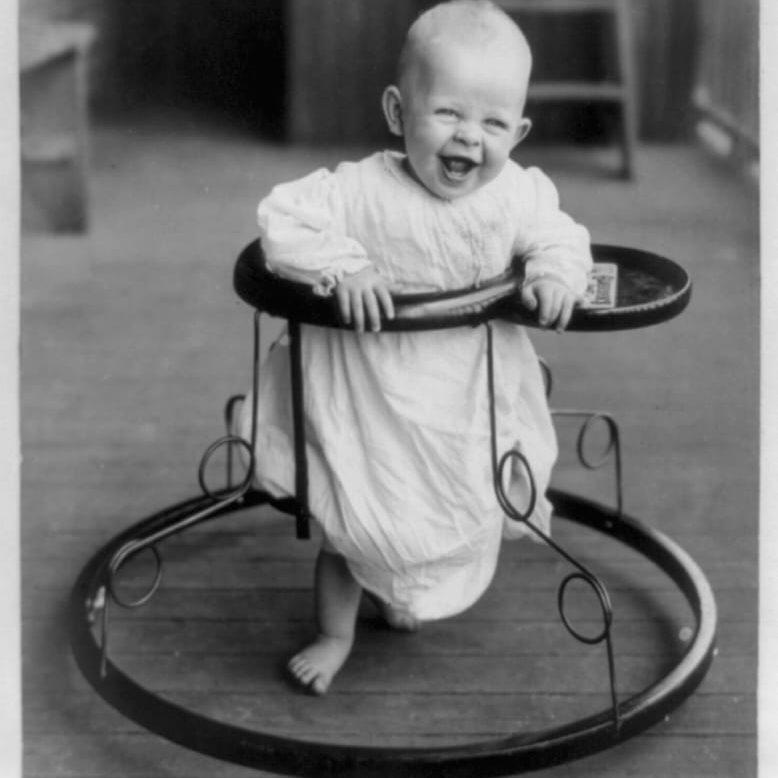
The Historical Review of Baby Walkers:
Key Points:
Ancient beginnings:
The history of baby walkers can be traced back to ancient times. Temporary devices resembling small vehicles were developed to provide support during early attempts to walk children.
17th to 19th centuries:
During this period, wooden structures resembling modern walkers emerged. However, the lack of safety features led to safety concerns, prompting a re-evaluation of Walker’s design.
20th-century innovation:
The 20th century saw significant advances with the use of materials such as steel and plastic, leading to more stable and safer walker designs. Features such as wheels, adjustable height, and foldable design became common.
Conflicts in the mid-20th century:
Conflicts emerged about the impact of pedestrians on children’s development, leading to concerns about the development of motor skills and potential delays in accidents. Regulatory bodies responded with safety standards.
From the late 20th century to the present, manufacturers implemented strict safety measures, including rubber grips, braking systems, and improved stability characteristics. Diverse designs, including traditional seat-in-walkers and push-walkers, meet different developmental stages.

Contemporary Trends:
In recent years, there has been a shift towards designing baby walkers to aid mobility and developmental benefits. Pedestrians now offer interactive toys, music, and sensory activities to engage and inspire children.
Continuous Evolution:
The history of baby walkers reflects an ongoing effort to balance innovation, safety, and developmental considerations. Baby walkers have evolved significantly from humble beginnings to today’s diverse, safety-conscious designs.
The invention and evolution of walking aids for infants trace back centuries, showcasing the human desire to support and nurture the development of the youngest members of our societies. While not specific to a particular Sun, the history of baby walkers reveals a fascinating journey across cultures and eras.
Historically, homemade contraptions served as the predecessors to modern baby walkers. In cultures worldwide, parents crafted simple structures to assist their babies in standing and taking those initial steps. These early walking aids varied widely, from rudimentary wooden frames with wheels to fabric slings attached to wheeled structures.
As industrialization influenced daily life in the late 19th century, companies began recognizing the market potential for products catering to childrearing. The first commercially produced baby walkers emerged in the early 20th century. While not as sleek or standardized as contemporary models, these walkers featured metal frames and wheels, providing a more structured approach to supporting a baby’s mobility.
In the 21st century, the narrative around baby walkers has shifted. The focus intensified on creating safer alternatives that would provide similar developmental benefits without the associated risks. Many contemporary baby walkers incorporate enhanced safety features, complying with rigorous standards. Some models even transform into stationary activity centers, aligning with the recommendations of pediatricians to minimize the potential hazards of traditional walkers.

Frequently Asked Questions ( FAQs )
What is the ancient beginning of baby walkers?
The baby walker is traced back to ancient times when temporary devices resembling small vehicles were used to help children in their early attempts to walk.
What were the developments from the 17th to the 19th century regarding baby walkers?
Wooden structures resembling modern walkers emerged during this period, but safety concerns led to a re-evaluation of their design due to a lack of safety features.
How did the 20th century contribute to the evolution of baby walkers?
Significant progress was made with the use of materials such as steel and plastic, leading to more stable and safer designs. Features such as wheels, adjustable height, and foldable design became common.
What controversies regarding baby walkers emerged in the mid-20th century?
Controversy arose about the impact of baby walkers on children’s development, leading to concerns about the development of motor skills and accidents. Regulatory bodies responded by enforcing safety standards.
What are the current trends in baby walker design?
In recent years, there has been a shift towards designing baby walkers to aid mobility and offer developmental benefits. Modern walkers incorporate interactive toys, music, and sensory activities to engage children.
Conclusion:
In conclusion, the history of baby walkers transcends specific years, weaving a global tale of human ingenuity and care for the youngest members of society. From humble homemade structures to sophisticated, safety-conscious designs, the journey reflects a continual quest to balance innovation with the paramount concern for child safety and development. As the sun continues to rise and set, the evolution of baby walkers remains a testament to the enduring commitment to nurturing and supporting the earliest steps of our little ones across time and cultures.
